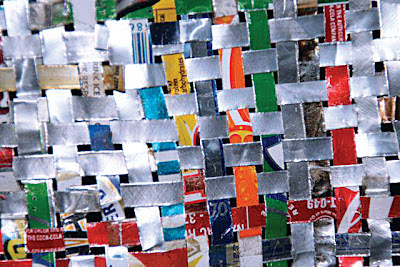By Tajudeen Sowole
Art may have
been taking a discourse-space on the quest for a stable Nigeria, but U.S-based
artist Moyo Okediji adds another perspective, saying the unfolding security
challenges in the country offers artists a new way of expression.
Okediji’s argument
formed the crust of his solo art exhibition titled The New Modern: Explosive Imageries, Incendiary Times just held at
Watersworth Gallery, Lekki Phase-One, Lagos.
Explaining what he called “cultural
shift across the world,” he noted the 2001 terror attack on U.S. now known as
9/11 as a major reality of the changing face of the world’s cultural landscape.
Nigeria, he argued, has its own 9/11. “I call it 6/16, which marks the first
suicide bomb attack in Nigeria on June 16, 2011,” Okediji told his visitor
during a visit to the gallery.
Indeed, the Boko Haram insurgence in
Northern Nigeria is the window through which Okediji addresses the effect of
“cultural shift,”. However, the challenges of multiculturalism over the last
few decades have been threatening the unity of the country.
And as government seems not to consider
the reality of multiculturalism, blaming the Boko Haram insurgence on power
shift, art, so suggests the texture of Okediji’s work, cannot afford to be lost
in the whirlwind of insecurity challenges facing the country.
 |
| Moyo Okediji’s Things Fall Apart (hand-woven metal, 2012) |
A near mural-size mat piece mounted at
the far right of the gallery, he said, represents the central theme. The woven
texture of the work, and indeed others in similar theme, he explained, “is a
metaphor for construction and not destruction.”
Okediji’s rendition and imploring of
materials, unlike some artists of the Diaspora, who recently showed at home,
indicates his understanding of the changing dynamics of the Nigerian art space.
In fact, he appears to have brought additional mentality onto the discourse
arena. He stated: “The Boko Haram angle is a new dimension invisibly embedded in
the conscious and subconscious of the New Modern in Nigerian art and culture.”
Art, he stressed, “cannot remain the same in this landscape of instability and
discontinuity.” This much, works such as Ceremony of the Innocent, No Man’s Land, Point of No Return, Falcon
and Falconet and Widening Gyre
stress.
Although Okediji’s thought on Boko Haram
dominates the air of the gallery, but he expands his themes on multiculturalism
via a set of figural and stylised images grouped under Pharaoh Series, and “inspired by post-disintegration of the Yoruba
military conflict.”
With the series, he shows a deeper
intellectuality that enlivens the seemingly dominant abstractive and soft metal
collage works. Without these equestrian images and others that depict contemporainety,
it could be difficult to place Okediji’s art in proper perspective, given his
long absence on the local art scene.
It’s easier, for example, to connect
Alex Nwokolo’s new works, laced with extensive imploring of soft metal, to his
recent periods well known to Nigerian art scene such as Oju and streetscape series, or Kolade Oshinowo’s new fabric to his
well established image in representational forms.
For Okediji, the closest one had of his
work came in the clay frieze-dominated joint show he had with Tola Wewe titled Return of Our Mother – a tribute to
Wewe’s kidnapped mother – showed at The Civic Centre, Lagos last year.
Really, did the work represent
Okediji’s art not known to the Nigerian art scene? “That’s me, exactly,” he
declared sharply, recalling that he did the works in Nigeria, accidentally,
when his friend Wewe was about to dispose of some clays as studio-wastes. “I
thought I could do something out of the clay, so I packed them and started
working,” he said. From pieces produced out of the rescued-clay, to his current
work Okediji may just have started a renewal of his identity at home.
A founding member of Onaism art movement, Okediji’s second
journey towards his possible lionising of Nigeria’s art space within the new
modern context would not come as a surprise, given the scope of his art
tutelage back home three decades ago.
He reminisced: “During my graduate days at
the University of Benin (toward the end of the 1970s), I began to explore
various alternative materials as means of color, as part of my desire to define
an African painting aesthetics.”
He added that his innocence offered him
the gamble “to build an African aesthetics of painting around mixed media and
found-objects, superimposed on indigenous techniques.” One of such techniques,
he disclosed, was weaving, which he learned to do via mats.The weaving technique, indeed,
resonates in The New Modern,
particularly in the soft metal works.
Okediji is currently an Associate Prof.
of African Art History at the University of Texas, Austin, U.S. He relocated to
the U.S. in the early 1990s after a teaching career at his alma mater
University of Ife (now Obafemi Awolowo University), Ile Ife to pursue his PhD
in African Art History at the University of Wisconsin, Madison.

No comments:
Post a Comment